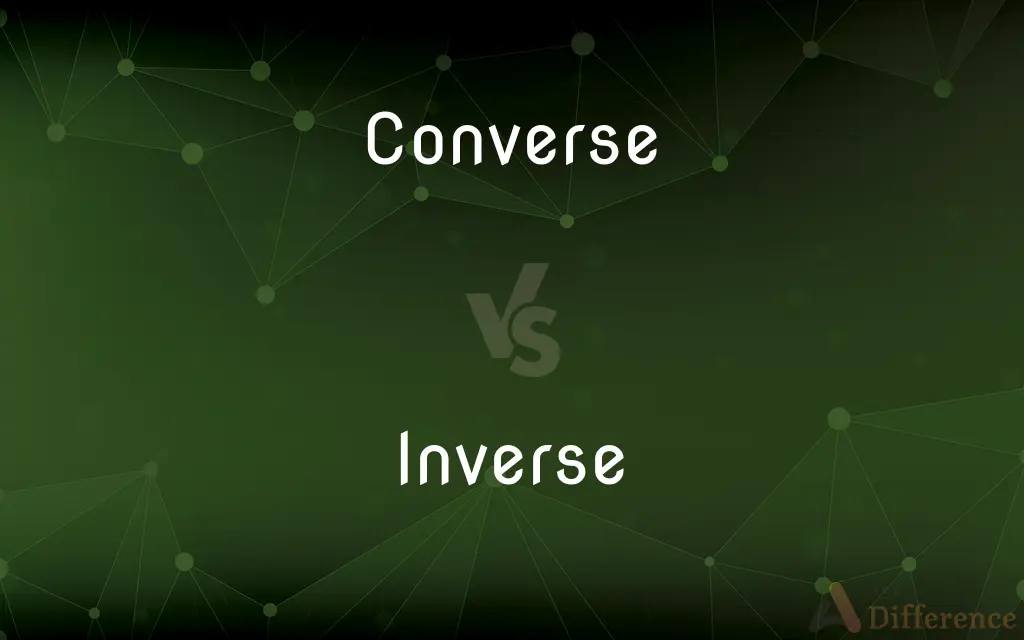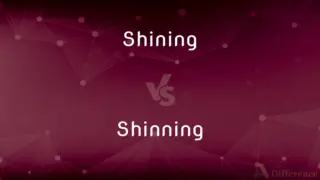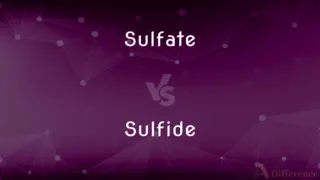Converse vs. Inverse — What's the Difference?
By Fiza Rafique & Urooj Arif — Updated on April 23, 2024
Converse statements reverse the logic of an original statement, focusing on conditional relationships, while inverse statements negate both components, altering the initial premise.

Difference Between Converse and Inverse
Table of Contents
ADVERTISEMENT
Key Differences
A converse statement involves swapping the hypothesis and conclusion of an initial conditional statement. For example, if the original statement is "If it rains, the ground is wet," its converse would be "If the ground is wet, it rains." On the other hand, an inverse statement negates both the hypothesis and conclusion of the original. Thus, for the same example, the inverse would be "If it does not rain, the ground is not wet."
In logic, the truth value of a converse statement can differ from that of the original statement. This means that even if the original statement is true, its converse might not be. Conversely, inverse statements also do not necessarily share the truth value with their original statements. They introduce a different conditional relationship by incorporating negation.
The usage of converse statements is prevalent in mathematical proofs and logical reasoning, where the implications of reversing conditions are explored. Whereas, inverse statements are often used to test the limits or boundaries of definitions or theories by considering what happens when conditions are not met.
Understanding the effectiveness of converse statements in arguments or proofs depends on the context and the nature of the logical relationship being considered. In contrast, inverse statements often serve as a tool to understand the necessity of certain conditions in a theorem or a logical setup.
The construction of converse and inverse statements is a fundamental skill in logic and mathematics, helping to develop critical thinking and deeper understanding of how conditions and outcomes are interrelated. Inversely, this skill also aids in comprehending scenarios where standard conditions are altered or not present.
ADVERTISEMENT
Comparison Chart
Definition
Reverses hypothesis and conclusion
Negates both hypothesis and conclusion
Logical Form
If Q then P (from If P then Q)
If not P then not Q (from If P then Q)
Truth Relationship
Does not necessarily maintain truth
Does not necessarily maintain truth
Usage
In proofs, reasoning
In theory testing, boundary exploration
Example
If A=B, then B=A (from If B=A, then A=B)
If not A=B, then not B=A (from If A=B, then B=A)
Compare with Definitions
Converse
Reversing the elements of a conditional statement.
The converse of If it is sunny, we will play outside is If we play outside, it is sunny.
Inverse
Involves negating both parts of a conditional statement.
The inverse of If it is cold, I will wear a coat is If it is not cold, I will not wear a coat.
Converse
Often used in mathematical contexts.
The converse of a known identity may not always hold true.
Inverse
Useful in hypothesis testing.
By testing the inverse, one can confirm the robustness of a hypothesis.
Converse
Examines potential equivalency of conditions.
Testing the converse helps in understanding logical equivalence.
Inverse
Common in logical deductions.
The inverse is used to explore conditions under which a statement fails.
Converse
Applied in logic to test implications.
In geometry, the converse of a theorem can provide new insights.
Inverse
Helps in understanding necessary versus sufficient conditions.
The inverse helps differentiate necessary conditions in logic.
Converse
Can lead to false assumptions if not validated.
The converse of a causation is not necessarily true.
Inverse
Critical in theoretical reasoning.
Using the inverse can challenge the boundaries of a theorem.
Converse
To engage in an exchange of thoughts and feelings by means of speech or sign language.
Inverse
Reversed in order, nature, or effect.
Converse
(Archaic) To interact socially with others; associate.
Inverse
(Mathematics) Of or relating to an inverse or an inverse function.
Converse
An interchange of thoughts and feelings by means of speech or sign language; conversation.
Inverse
(Archaic) Turned upside down; inverted.
Converse
Social interaction.
Inverse
Something that is opposite, as in sequence or character; the reverse.
Converse
Something that has been reversed; an opposite.
Inverse
The reciprocal of a designated quantity. Also called multiplicative inverse.
Converse
(Logic) A proposition obtained by conversion.
Inverse
The negative of a designated quantity. Also called additive inverse.
Converse
Reversed, as in position, order, or action; contrary.
Inverse
Opposite in effect, nature or order.
Converse
To talk; to engage in conversation.
Inverse
Reverse, opposite in order.
Converse
(followed by with) To keep company; to hold intimate intercourse; to commune.
Inverse
(botany) Inverted; having a position or mode of attachment the reverse of that which is usual.
Converse
(obsolete) To have knowledge of (a thing), from long intercourse or study.
Inverse
(mathematics) Having the properties of an inverse; said with reference to any two operations, which, when both are performed in succession upon any quantity, reproduce that quantity.
Multiplication is the inverse operation to division.
Converse
Free verbal interchange of thoughts or views; conversation; chat.
Inverse
(geometry) That has the property of being an inverse (the result of a circle inversion of a given point or geometrical figure); that is constructed by circle inversion. Category:en:Curves
A circle inversion maps a given generalized circle to its inverse generalized circle.
Converse
The opposite or reverse.
Inverse
Whose every element has an inverse (morphism which is both a left inverse and a right inverse).
Converse
(logic) Of a proposition or theorem of the form: given that "If A is true, then B is true", then "If B is true, then A is true.".
All trees are plants, but the converse, that all plants are trees, is not true.
Inverse
An inverted state: a state in which something has been turned (properly) upside down or (loosely) inside out or backwards.
Cowgirl is the inverse of missionary.
321 is the inverse of 123.
Converse
(semantics) One of a pair of terms that name or describe a relationship from opposite perspectives; converse antonym; relational antonym.
Inverse
The result of an inversion, particularly:
Converse
Opposite; reversed in order or relation; reciprocal
A converse proposition
Inverse
The reverse of any procedure or process.
Uninstalling is the inverse of installation.
Converse
To keep company; to hold intimate intercourse; to commune; - followed by with.
To seek the distant hills, and there converseWith nature.
Conversing with the world, we use the world's fashions.
But to converse with heaven -This is not easy.
Inverse
(mathematics) A ratio etc. in which the antecedents and consequents are switched.
The inverse of a:b is b:a.
Converse
To engage in familiar colloquy; to interchange thoughts and opinions in a free, informal manner; to chat; - followed by with before a person; by on, about, concerning, etc., before a thing.
CompanionsThat do converse and waste the time together.
We had conversed so often on that subject.
Inverse
(geometry) The result of a circle inversion; the set of all such points; the curve described by such a set.
The inverse P‘ of a point P is the point on a ray from the center O through P such that OP × OP‘ = r² or the set of all such points.
Converse
To have knowledge of, from long intercourse or study; - said of things.
According as the objects they converse with afford greater or less variety.
Inverse
(logic) The non-truth-preserving proposition constructed by negating both the premise and conclusion of an initially given proposition.
"Anything that isn't a dog doesn't go to heaven" is the inverse of "All dogs go to heaven." More generally, is the inverse of and is equivalent to the converse proposition .
Converse
Frequent intercourse; familiar communion; intimate association.
"T is but to holdConverse with Nature's charms, and view her stores unrolled.
Inverse
(mathematics) A second element which negates a first; in a binary operation, the element for which the binary operation—when applied to both it and an initially given element—yields the operation's identity element, specifically:
Converse
Familiar discourse; free interchange of thoughts or views; conversation; chat.
Formed by thy converse happily to steerFrom grave to gay, from lively to severe.
Inverse
(addition) The negative of a given number.
The additive inverse of is , as , as is the additive identity element.
Converse
A proposition which arises from interchanging the terms of another, as by putting the predicate for the subject, and the subject for the predicate; as, no virtue is vice, no vice is virtue.
Inverse
(multiplication) One divided by a given number.
The multiplicative inverse of is , as , as the multiplicative identity element.
Converse
A proposition in which, after a conclusion from something supposed has been drawn, the order is inverted, making the conclusion the supposition or premises, what was first supposed becoming now the conclusion or inference. Thus, if two sides of a sides of a triangle are equal, the angles opposite the sides are equal; and the converse is true, i.e., if these angles are equal, the two sides are equal.
Inverse
(functions) A second function which, when combined with the initially given function, yields as its output any term inputted into the first function.
The compositional inverse of a function is , as , as is the identity function. That is, .
Converse
Turned about; reversed in order or relation; reciprocal; as, a converse proposition.
Inverse
(category theory) A morphism which is both a left inverse and a right inverse.
Converse
A proposition obtained by conversion
Inverse
(card games) The winning of the coup in a game of rouge et noir by a card of a color different from that first dealt; the area of the table reserved for bets upon such an outcome.
Converse
Carry on a conversation
Inverse
A grammatical number marking that indicates the opposite grammatical number (or numbers) of the default number specification of noun class.
Converse
Of words so related that one reverses the relation denoted by the other;
`parental' and `filial' are converse terms
Inverse
(surveying) To compute the bearing and distance between two points.
Converse
Turned about in order or relation;
Transposed letters
Inverse
Opposite in order, relation, or effect; reversed; inverted; reciprocal; - opposed to direct.
Inverse
Inverted; having a position or mode of attachment the reverse of that which is usual.
Inverse
Opposite in nature and effect; - said with reference to any two operations, which, when both are performed in succession upon any quantity, reproduce that quantity; as, multiplication is the inverse operation to division. The symbol of an inverse operation is the symbol of the direct operation with -1 as an index. Thus sin-1 x means the arc or angle whose sine is x.
Inverse
That which is inverse.
Thus the course of human study is the inverse of the course of things in nature.
Inverse
Something inverted in sequence or character or effect;
When the direct approach failed he tried the inverse
Inverse
Reversed (turned backward) in order or nature or effect
Inverse
Opposite in nature or effect or relation to another quantity ;
A term is in inverse proportion to another term if it increases (or decreases) as the other decreases (or increases)
Common Curiosities
What is an inverse statement?
An inverse statement negates both the hypothesis and the conclusion of a conditional statement.
Are inverse statements the same as the original statements?
No, inverses alter the initial conditions by negating them and do not necessarily maintain the original's truth.
Do converse statements always hold true?
No, the truth value of a converse statement may differ from the original statement.
What is a converse statement?
A converse statement reverses the hypothesis and conclusion of an original conditional statement.
What is the importance of inverse statements in logic?
They help understand the necessity of certain conditions and explore the limits of definitions.
Is there a logical equivalent for every converse statement?
Not necessarily; the logical equivalence of converse statements depends on the specific conditions and contexts.
What does negating a hypothesis and conclusion involve?
It means asserting the opposite of both the initial condition and its resultant outcome.
Why are inverse statements significant in theory testing?
They provide a method to examine what happens when the initial assumptions of a theory are not met.
How are converse statements used in mathematics?
They are used to test the implications and logical strength of theorems and conjectures.
Can the truth of a converse statement be tested?
Yes, through logical deduction and empirical evidence, the validity of a converse can be assessed.
Can using converse and inverse statements lead to new discoveries?
Yes, exploring these statements can lead to new insights and understanding in various fields.
How do converse and inverse statements differ in their logical form?
The converse swaps the components, while the inverse negates both.
How should one approach the validation of converse statements?
Through logical reasoning, mathematical proof, and empirical testing.
What role do inverse statements play in hypothesis testing?
They are critical in verifying the limits and essential conditions of hypotheses.
What are some common errors in using converse statements?
Assuming that the converse of a true statement is automatically true can lead to logical fallacies.
Share Your Discovery

Previous Comparison
Shining vs. Shinning
Next Comparison
Sulfate vs. SulfideAuthor Spotlight
Written by
Fiza RafiqueFiza Rafique is a skilled content writer at AskDifference.com, where she meticulously refines and enhances written pieces. Drawing from her vast editorial expertise, Fiza ensures clarity, accuracy, and precision in every article. Passionate about language, she continually seeks to elevate the quality of content for readers worldwide.
Co-written by
Urooj ArifUrooj is a skilled content writer at Ask Difference, known for her exceptional ability to simplify complex topics into engaging and informative content. With a passion for research and a flair for clear, concise writing, she consistently delivers articles that resonate with our diverse audience.














































